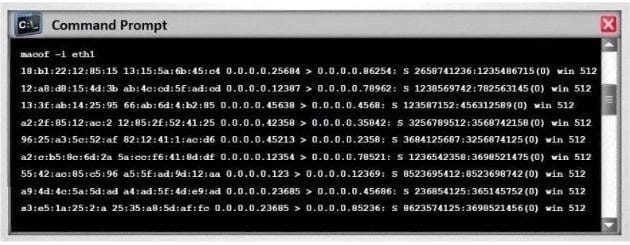Exam Details
Exam Code
:312-50V11Exam Name
:EC-Council Certified Ethical Hacker (C|EH v11)Certification
:EC-COUNCIL CertificationsVendor
:EC-COUNCILTotal Questions
:528 Q&AsLast Updated
:Apr 17, 2025
EC-COUNCIL EC-COUNCIL Certifications 312-50V11 Questions & Answers
-
Question 371:
Steve, a scientist who works in a governmental security agency, developed a technological solution to identify people based on walking patterns and implemented this approach to a physical control access.
A camera captures people walking and identifies the individuals using Steve's approach.
After that, people must approximate their RFID badges. Both the identifications are required to open the door. In this case, we can say:
A. Although the approach has two phases, it actually implements just one authentication factor
B. The solution implements the two authentication factors: physical object and physical characteristic
C. The solution will have a high level of false positives
D. Biological motion cannot be used to identify people
-
Question 372:
John, a professional hacker, decided to use DNS to perform data exfiltration on a target network, in this process, he embedded malicious data into the DNS protocol packets that even DNSSEC cannot detect. Using this technique. John successfully injected malware to bypass a firewall and maintained communication with the victim machine and CandC server. What is the technique employed by John to bypass the firewall?
A. DNS cache snooping
B. DNSSEC zone walking
C. DNS tunneling method
D. DNS enumeration
-
Question 373:
If a tester is attempting to ping a target that exists but receives no response or a response that states the destination is unreachable, ICMP may be disabled and the network may be using TCP. Which other option could the tester use to get a response from a host using TCP?
A. Traceroute
B. Hping
C. TCP ping
D. Broadcast ping
-
Question 374:
which of the following information security controls creates an appealing isolated environment for hackers to prevent them from compromising critical targets while simultaneously gathering information about the hacker?
A. intrusion detection system
B. Honeypot
C. Botnet
D. Firewall
-
Question 375:
_________ is a tool that can hide processes from the process list, can hide files, registry entries, and intercept keystrokes.
A. Trojan
B. RootKit
C. DoS tool
D. Scanner
E. Backdoor
-
Question 376:
Switches maintain a CAM Table that maps individual MAC addresses on the network to physical ports on the switch.

In MAC flooding attack, a switch is fed with many Ethernet frames, each containing different source MAC addresses, by the attacker. Switches have a limited memory for mapping various MAC addresses to physical ports. What happens when the CAM table becomes full?
A. Switch then acts as hub by broadcasting packets to all machines on the network
B. The CAM overflow table will cause the switch to crash causing Denial of Service
C. The switch replaces outgoing frame switch factory default MAC address of FF:FF:FF:FF:FF:FF
D. Every packet is dropped and the switch sends out SNMP alerts to the IDS port
-
Question 377:
Shellshock allowed an unauthorized user to gain access to a server. It affected many Internet-facing services, which OS did it not directly affect?
A. Linux
B. Unix
C. OS X
D. Windows
-
Question 378:
What is not a PCI compliance recommendation?
A. Use a firewall between the public network and the payment card data.
B. Use encryption to protect all transmission of card holder data over any public network.
C. Rotate employees handling credit card transactions on a yearly basis to different departments.
D. Limit access to card holder data to as few individuals as possible.
-
Question 379:
Jane is working as a security professional at CyberSol Inc. She was tasked with ensuring the authentication and integrity of messages being transmitted in the corporate network. To encrypt the messages, she implemented a security model in which every user in the network maintains a ring of public keys. In this model, a user needs to encrypt a message using the receiver's public key, and only the receiver can decrypt the message using their private key. What is the security model implemented by Jane to secure corporate messages?
A. Zero trust network
B. Transport Layer Security (TLS)
C. Secure Socket Layer (SSL)
D. Web of trust (WOT)
-
Question 380:
Bobby, an attacker, targeted a user and decided to hijack and intercept all their wireless communications.
He installed a fake communication tower between two authentic endpoints to mislead the victim. Bobby
used this virtual tower to interrupt the data transmission between the user and real tower, attempting to
hijack an active session, upon receiving the users request. Bobby manipulated the traffic with the virtual
tower and redirected the victim to a malicious website.
What is the attack performed by Bobby in the above scenario?
A. Wardriving
B. KRACK attack
C. jamming signal attack
D. aLTEr attack
Related Exams:
112-51
EC-Council Certified Network Defense Essentials (NDE)212-77
EC-Council Certified Linux Security212-81
EC-Council Certified Encryption Specialist (ECES)212-82
EC-Council Certified Cybersecurity Technician (C|CT)212-89
EC-Council Certified Incident Handler (ECIH)312-38
EC-Council Certified Network Defender (CND)312-39
EC-Council Certified SOC Analyst (CSA)312-40
EC-Council Certified Cloud Security Engineer (CCSE)312-49
ECCouncil Computer Hacking Forensic Investigator (V9)312-49V10
EC-Council Certified Computer Hacking Forensic Investigator (V10)
Tips on How to Prepare for the Exams
Nowadays, the certification exams become more and more important and required by more and more enterprises when applying for a job. But how to prepare for the exam effectively? How to prepare for the exam in a short time with less efforts? How to get a ideal result and how to find the most reliable resources? Here on Vcedump.com, you will find all the answers. Vcedump.com provide not only EC-COUNCIL exam questions, answers and explanations but also complete assistance on your exam preparation and certification application. If you are confused on your 312-50V11 exam preparations and EC-COUNCIL certification application, do not hesitate to visit our Vcedump.com to find your solutions here.